Lær om beste praksis for spørreundersøkelser og skjemaer
Få mest mulig ut av spørreundersøkelsene og skjemaene med ressurser og artikler fra SurveyMonkey-teamet.






Utforsk ressursene våre
Beste praksis for spørreundersøkelser | Tilbakemelding fra kunder | Markedsundersøkelser | Tilbakemelding fra medarbeidere | Skjemaer | Forskning og analyse | Produktutvikling | Arrangementadministrering | Markedsføring | Spørreundersøkelser for utdanning | Spørreundersøkelser for helsevesen | Quizer | Spørreundersøkelser for ideelle organisasjoner
Fremhevede artikler

Regn ut Net Promoter Score® nøyaktig og oppdag tips for å forbedre rangeringen din.

Er medarbeiderne fornøyde? Finn ut hvordan dere lager effektive spørsmål i spørreundersøkelser for å finne ut.
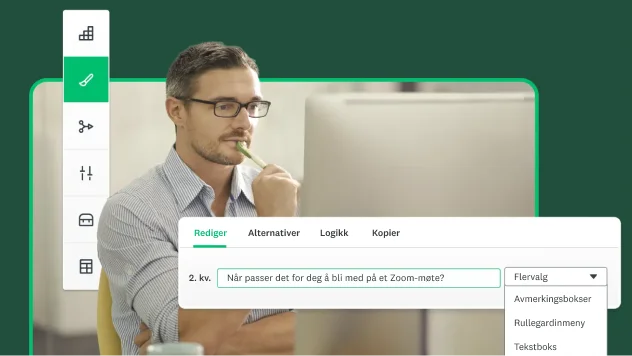
Oppdag den enkle måten å koordinere møtetider på som fungerer for teamet.

Hvor mange respondenter trengs for en spørreundersøkelse? Bruk utvalgsstørrelsekalkulatoren for å få best mulig resultater.
Beste praksis for spørreundersøkelser

Beste praksis for spørreundersøkelser og retningslinjer for design
Lag spørreundersøkelser, samle inn svar og analyser dataene som en proff.
Finn ut hvordan dere lager spørreundersøkelser, innhenter svar og analyserer data for å ta bedre forretningsavgjørelser.
Få umiddelbar tilbakemelding for å måle meninger og ta avgjørelser basert på sanntidsdata.
Lær om de vanligste typene skjevhet i spørreundersøkelser og hvordan man kan unngå dem i spørreundersøkelsene.
Finn ut mer om en av de mest pålitelige metodene for å måle meninger, oppfatninger og atferd, og hvordan de kan brukes i den neste spørreundersøkelsen.
Utforsk vanlige spørsmål i spørreundersøkelser og finn ut hvordan dere kan lage effektive spørreundersøkelser som gir mest mulig resultater.
Tilbakemelding fra kunder

Slik lages vellykkede programmer for tilbakemelding fra kunder
Lær beste praksis for innhenting og bruk av tilbakemeldinger for å forbedre produkter, tjenester og kundeforhold.
Oppdag hvordan man kan bruke poengsummen for kundeinnsats for å redusere friksjon og øke lojalitet.
Finn ut hvordan dere beregner NPS og lager en spørreundersøkelse for å måle kundeopplevelse og -tilfredshet.
Utforsk fordelene og begrensningene med NPS og hvorfor det brukes ofte til å måle kundelojalitet og forutse forretningsvekst.
Finn ut hvordan dere lager bedre spørsmål i spørreundersøkelser om kundetilfredshet for å innhente nyttig innsikt.
Måling av de fem dimensjonene innen tjenestekvalitet kan bidra til med å finne nye måter å gjøre kundene fornøyde og forbedre opplevelsen deres på.
Markedsundersøkelser
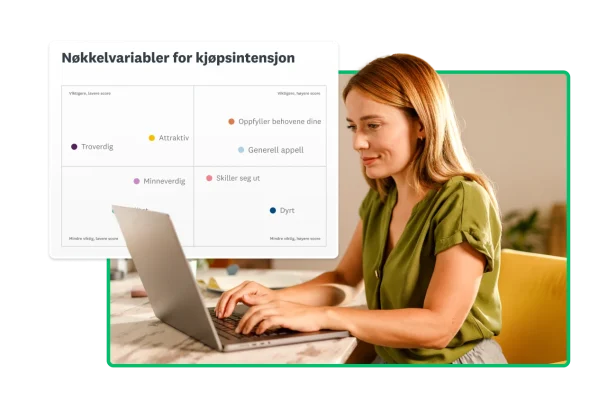
Markedsundersøkelse: Hva er det, hvorfor er det viktig, og hvordan kommer man i gang?
Finn ut om denne strategien med data først som gir praktisk innsikt i forbrukere, holdninger og bredere markeder.
Finn ut hvordan man lager spennende spørreundersøkelser for markedsundersøkelse på få minutter.
Finn ut hvordan sekundærforskning er forskjellig fra primærforskning, og hvorfor dere bør bruke det.
Få informasjonen dere trenger for å ta bedre avgjørelser for produktene og tjenestene.
Er resultatene statistisk signifikante? Bruk denne kalkulatoren for å sikre at dere får pålitelige resultater fra spørreundersøkelser.
Medarbeidertilbakemeldinger
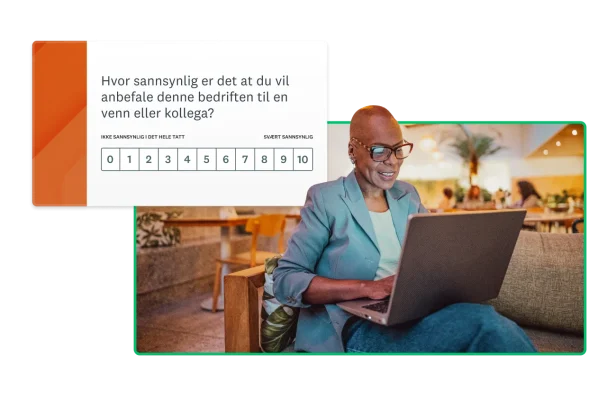
Tilbakemelding fra medarbeidere: Tips, eksempler og maler
Finn ut hvordan dere stiller riktige spørsmål, lager et solid program for tilbakemeldinger fra medarbeidere og bruker resultatene for å beholde de ansatte.
Finn ut hvilke spørsmål dere kan stille for å forbedre rekrutteringsprosessen og tiltrekke de beste kandidatene.
Utforsk fordelene med å bruke spørreundersøkelser for medarbeidere for å forbedre engasjementet, identifisere problemer på arbeidsplassen og forbedre organisasjonskulturen.
Støtt medarbeiderne med spørreundersøkelser om opplæring for å evaluere effektiviteten til opplæringsprogrammer og identifisere forbedringsområder.
Lær strategier for å fostre en sunn arbeidskultur via tydelig kommunikasjon, anerkjennelse og inklusivitet.
Få maler for spørreundersøkelser og ekspertveiledning for å hjelpe organisasjonen med å skape en med inklusiv kultur.
Skjemaer
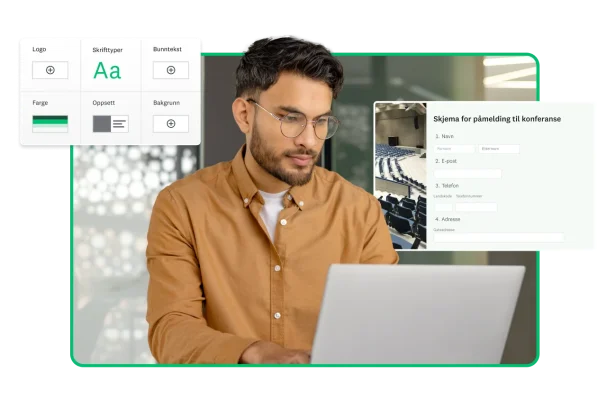
Opprette nettskjemaer
Lag nettskjemaer enkelt med SurveyMonkey og begynn å samle inn svar umiddelbart.
Få veiledning om design av effektive nettskjemaer, inkludert beste praksis for struktur, spørsmålstyper og brukererfaring.
Lag registreringsskjemaer på nettet som er enkle å tilpasse og fylle ut. Velg den malen som dekker behovene.
Innhent tilbakemeldinger direkte fra kunder og andre for å forbedre bedriften, produktet eller merkevaren.
Få tips om opprettelse av skjemaer for arrangementsbekreftelse og finn ut hvordan dere samler inn og sporer svar fra gjester for å administrere deltakelse på arrangementer på en effektiv måte.
Øk svarfrekvenser, registrer kontaktinformasjon og forenkle registreringer og bruksområder med skjemaer som kan innebygges.
Forskning og analyse

Slik analyseres spørreundersøkelsesdata: metoder og eksempler
Finn ut hvordan dere analyserer spørreundersøkelsesdata effektivt og lager bedre spørreundersøkelser enkelt.
Med riktig informasjon og riktige verktøy kan statistiske metoder brukes for å analysere spørreundersøkelsesdataene uten å være ekspert.
Få et dyptgående innblikk på undersøkende forskning og lær fire måter å implementere den på i forskningen.
Forstå årsak-og-virkningsforhold og ta informerte beslutninger ved å teste hypoteser og undersøke resultater.
Sjekk tipsene våre for bruk av kvantitativ undersøkelse for å forbedre bedriftens spørreundersøkelser.
Finn ut hvordan man finner feilmargin og bruker nettkalkulatoren vår til å måle den umiddelbart.
Produktutvikling
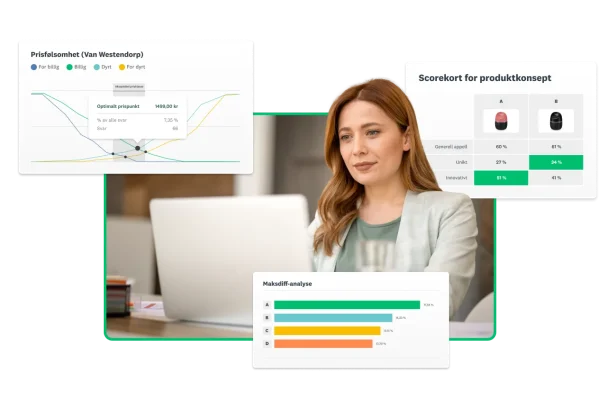
Bygge bedre produkter raskere med tilbakemelding nesten i sanntid
Finn ut hvordan dere bruker spørreundersøkelser i løpet av prosessen for produktutvikling for å innhente tilbakemeldinger fra kunder, identifisere behov og veilede produktforbedringer.
Finn ut hvordan screening av ideer kan bidra til å lage vellykkede produkter støttet av forskning og analyse.
Vurder kundenes betalingsvillighet, noe som gir innsikt for prisstrategier og markedsetterspørsel.
Innhent innsikt før og etter lansering for å forbedre produkt og kundetilfredshet.
Få produktkonsepter og -ideer bekreftet av en pålitelig målgruppe – på mindre enn én time.
Finn ut hvordan man planlegger, designer, sender og analyserer en spørreundersøkelse for konsepttesting for å forbedre neste annonsekampanje, produktlansering med mer.
Arrangementsledelse

Administrering av tilbakemeldinger for arrangementer: Spørreundersøkelser før og etter arrangementet
Få tips og maler for å gjøre det neste arrangementet vellykket fra begynnelse til slutt.
Finn ut hvilke spørsmål for spørreundersøkelser for arrangement som kan stilles for å innhente nyttige tilbakemeldinger i hvert trinn av arrangementet.
Få forhåndslagde maler for spørreundersøkelser for arrangementsplanlegging, noe som gjør det enklere å innhente deltakerpreferanser og forventninger.
Oppnå mer vellykkede arrangementer ved å bruke spørreundersøkelser til å samle inn tilbakemeldinger fra deltakerne.
Eksperttips for innhenting av praktisk innsikt for å forbedre det neste bedriftsarrangementet eller den neste firmafesten.
Vær godt forberedt, hold deg organisert, og bruk SurveyMonkey-verktøy til å få arrangementene dine til å gå knirkefritt av stabelen.
Markedsføring

Spørreundersøkelser for markedsføring: eksempelspørsmål, eksempler med mer
Opprett en markedsundersøkelse på minutter og få opplysningene dere trenger for å forbedre kundetilfredsheten, produkter, priser, kreative kampanjer og mye mer.
Utvikle markedsføringsinnsikt for smartere og mer strategiske forretningsavgjørelser.
Lær beste praksis for utførelse av en annonsetest – fra idémylding av spørsmål til analysering av resultatene – for å finne det beste alternativet.
Spor ytelsen til merkevaren og se hvordan den utvikles over tid.
Finn ut hvordan dere får overbevisende data for markedsføring av innhold med originale undersøkelser.
Oppdag hvordan fagfolk i bransjen bruker KI innen markedsføring, og sett deg inn i SurveyMonkeys undersøkelsesstatistikk om bruken av KI.
Utdanningsspørreundersøkelser

Spørreundersøkelser for utdanning for skoler, lærere og elever
Vi har samarbeidet med det amerikanske utdanningsdepartementet og Harvard Graduate School of Education for å lage maler for spørreundersøkelser som fører til pedagogiske forbedringer.
Send spørreundersøkelse for utdanning til elever, studenter, lærere og foreldre for å finne ut hvordan skolen eller universitetet presterer – og andre ting.
Forstå elevbehov, -preferanser og -utfordringer, slik at dere kan lage et mer støttende utdanningsmiljø.
Transformer undervisningen med spørsmål for spørreundersøkelser for elever. Få ærlige tilbakemeldinger om leksjoner, aktiviteter og mer for bedre undervisning.
Bruk malen for spørreundersøkelser fra SurveyMonkey og Harvard Graduate School of Education K-12 for å forbedre foreldreengasjementet.
Få mer dybde i akademisk forskning med data og innsikt innhentet fra spørreundersøkelser.
Undersøkelser for helsevesenet

Spørreundersøkelser for helsevesen: spørsmål og maler
Bruk spørreundersøkelser for helsevesen for å innhente tilbakemeldinger fra pasienter, forbedre kvaliteten på omsorgen og støtte beslutningstaking på sykehus og helseinstitusjoner.
Bruk spørreundersøkelser om pasienttilfredshet for å vurdere opplevelser med helsevesenet og oppnå forbedringer av pasientomsorg.
Bruk denne malen for spørreundersøkelse for å evaluere og forbedre pasientsikkerhetskulturen i helseorganisasjonen.
Finn ut hvordan dere bruker spørreundersøkelser til å innhente kritiske data for kliniske studier, pasientresultater og utvikling av helsetjenester.
Finn ut hvordan SurveyMonkey støtter kunder med krav om HIPAA-samsvar.
Få eksempler på vurderingsspørsmål og eksempler på spørreundersøkelser for helsevesenet, og finn ut hvordan dere skriver spørsmål for spørreundersøkelser for helsevesenet.
Quizer

Lag effektive quizer med disse tipsene om spørsmålsutforming, formatering og bruk av quizer for engasjement og vurdering.
Veldedige organisasjoner

Få nyttige tilbakemeldinger fra donorer, frivillige og pengeinnsamlere med spørreundersøkelser på nettet.
Net Promoter, Net Promoter Score og NPS er varemerker for Satmetrix Systems, Inc., Bain & Company, Inc. og Fred Reichheld.